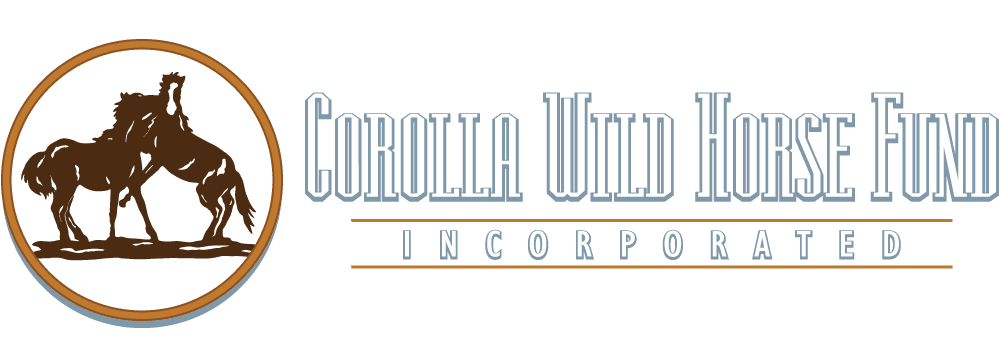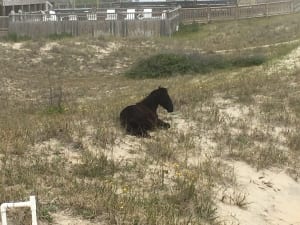Care and Management – Removing a Horse From the Wild (or not)
Our post about Valor yesterday generated a lot of discussion about why we remove horses from the beach, what motivates that decision, and the reasons why a horse cannot be returned to the wild once it’s removed. Today we’ll try to answer those questions and provide some examples of other ways we manage and care for the horses.
First and foremost, it’s important to understand that these decisions do not happen in a vacuum. Before removing any horse, our veterinarian is consulted, our board of directors is notified, and protocols set forth in the Wild Horse Management Agreement are followed. Our trainer and herd manager have nearly 70 combined years of experience working with horses, and we never hesitate to reach out to other wildlife professionals for input and advice. Even during an intense emergency situation like Valor’s, these phone calls are made and proper procedures are followed at all times.
Removing a horse from the wild is not a decision that we take lightly. It’s the last-resort option and the decision is only made when it’s clear the horse is suffering from catastrophic, fatal injury or illness that prevents it from keeping up with its family group, traveling to fresh water, and/or eating. If the condition is being caused by end-of-life complications (failing teeth, arthritis, etc.) we do our best to monitor the horse but allow it to live out its life naturally. We will intervene and humanely euthanize in the field when it becomes clear the horse is needlessly suffering and clearly not going to recover.
Why can’t a horse be returned to the wild once it’s removed? The Corolla herd is not vaccinated. Due to the isolation of the herd, it is naturally protected from disease spread by domestic horses. No domestic livestock is allowed into the horses’ habitat, and once we put a horse on a trailer and take it across the cattle guard, it is considered domestic livestock. Once at the farm, the horse is exposed to vaccinated horses (even though horses are quarantined for 30 days…disease can still spread) and could potentially pick up something easily treated in captivity (an upper respiratory infection, for example), that would be devastating should it spread to the wild herd. Horses removed from the beach are vaccinated as soon as it is safe to do so (Valor has already been vaccinated).
Horses that are removed from the wild require intensive, hands-on treatment and receive a crash course in domestication. Valor is already enjoying being scratched and pet, she is not leery of humans anymore at all, and she is being fed and offered fresh water regularly. Removing her from the wild and then keeping her isolated and only interacting with her for medical treatment would be incredibly inhumane. Additionally, it’s highly unlikely Valor would be easily accepted back into her family group if she were returned to the wild after months of treatment at the farm. The stress of a transition like that could very easily kill a horse.
It’s also important not to anthropomorphize wild animals. They do not process emotions in the same way that humans do, and assuming so can be very harmful. Horses, like most animals, are very good at living in the moment as long as their basic needs are being met. A healthy, enriched, horse is not standing in the field longing for its days in the wild. It is our responsibility to make sure the horses’ needs are being met in captivity, and this includes not only the basics like food and water, but also physical and mental activity, companionship, and a living environment that is as close to natural as we can make it.
Every situation is different, but here are some examples that might help demonstrate all the ways we manage the horses, and how we arrive at many of these decisions.
- You may remember Trooper, the horse that was bit by another stallion several years ago. What a nasty wound, huh? Naturally the first reaction is “yikes we need to bring him in!” But upon closer observation, we saw that Trooper was maintaining decent body condition (no, he is not skinny…body condition scoring is a post for another day, though), he was active, he had full range of motion, and the wound was clean and healing despite the severity of it. Our vet recommended leaving him in the wild and closely monitoring him. We consulted several wildlife experts who all agreed that leaving him in the wild to heal was the best thing for him. We watched Trooper’s injury grow smaller and smaller all summer, and by the fall only a small scare remained. The following summer, Trooper was fatally kicked by another stallion and we euthanized him, sad but also grateful that the old stallion got to live one more year in the wild and then die in the place he’d always called home.
- Anne Bonny lost her eye last year, most likely from the same condition Amadeo suffered from. We kept a close watch on her as the eye deteriorated, kept our vet posted with photos, and remained ready to intervene should she begin to struggle at all. However, she stayed in excellent body condition, kept up with her harem, and didn’t seem otherwise affected so we left her alone. Was it painful? Probably. But the side effects of losing the eye did not amount to enough of a reason to remove her. Anne’s quality of life never deteriorated so there was no need to intervene. If, like Amadeo, she begins to lose the other eye we will take her to the farm because a completely blind horse would not survive in the wild. For now she is managing just fine with one eye.
- Oh Captain. Such a cool old guy, and a great example of how we manage the horses. Early last spring we noticed that he had started dropping weight, but decided to wait and watch as the grass started to come back in. By June, he was still very skinny but he was very active, travelling significant distances to graze and drink, and hunkering down in the shade to rest during the heat of the day. He was bright and alert, and always got annoyed when we bothered him to check in. Always a good sign. It was clear that while Captain was quickly approaching the end of his life, he didn’t want any help from us in the meantime. So we got into the routine of checking on him every day, and got regular updates from the residents of the houses whose carports he napped under every afternoon. In August he was spotted with a significant amount of discharge coming from his nose and eye. Upon closer inspection, it was apparent he had an abscess under his eye that had ruptured, indicating an infection likely caused by a rotten tooth. Captain would not survive this without intervention, so we were faced with a choice. Euthanize him in the wild or remove him and see if we could treat the infection and give him a little bit more time to live peacefully on the farm. Captain was still alert and active, so we decided to give him a chance. Ultimately, we made the decision to euthanize him but for about a month Captain was spoiled rotten by everyone at the farm. He died with a full belly and surrounded by love, and we knew the right call had been made.
- If we had a nickel for every call we got about Taco we’d be rich! Yep, that’s a big lump. No, it doesn’t seem to bother him. It’s been there for years and has never slowed him down. But over the last couple months it has gotten noticeably bigger. so a couple weeks ago we brought our vet up to get a look at it in person. It’s mostly fluid, probably nothing to be concerned about, but there’s no reason we shouldn’t drain it once the weather cools off and the bugs aren’t bad. So in the fall we will catch him and perform the procedure in the field, then release him to heal up while we keep a close eye on him. He’s a young, healthy stallion and should have no problem recovering from a simple procedure like that on his own. There is always a chance the vet might find something unexpected once she begins the procedure, or the wound may require more care than we can provide in the field, and we have to remove Taco anyway. Hopefully that won’t be the case but we will be prepared for anything.
Every horse is different, and no case will ever be the same. We learn from each removal, birth, death, and emergency, and then apply that knowledge to the next situation. With fewer than 100 of these horses left here in the wild, it’s critically important that we give each and every one of them the chance to contribute their genes to the herd. We won’t lose a valuable member of this highly threatened breed when we can remove them and potentially save their life. And their lives do go on! We are developing a conservation program for the farm that includes breeding to Shackleford stallions, we do tons of outreach and education with the horses, and some of them are even adopted out to new families. But no matter what, all of the horses have one true purpose – be a Banker. That’s all we expect from them. Coming off the beach doesn’t make them any less a Banker horse, or any less important to the herd.
We strive to do everything possible to keep them wild, in the place where they’ve lived for the last five centuries. But when that’s not possible, we will provide them with a safe home for the rest of their lives where they will continue to contribute to the conservation of the herd in many different ways.







